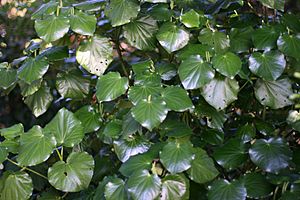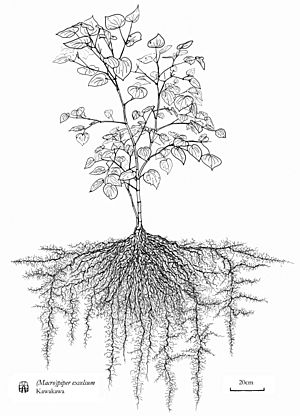Kawakawa facts for kids
Quick facts for kids Kawakawa |
|
|---|---|
 |
|
| Scientific classification | |
| Genus: |
Piper
|
| Species: |
excelsum
|
| Synonyms | |
|
Macropiper excelsum (G.Forst.) Miq. |
|
Kawakawa is a special small tree found in New Zealand. Its scientific name is Piper excelsum. You might also hear it called Macropiper excelsum. It's a native plant, meaning it naturally grows here. A similar type of kawakawa is also found on Lord Howe Island, Norfolk Island, and the Kermadec Islands.
Contents
What is Kawakawa?
Kawakawa grows all over New Zealand's North Island. You can also find it in parts of the South Island, like Okarito and Banks Peninsula. You might notice small holes in the leaves. These are often made by a caterpillar called the kawakawa looper moth. The name kawakawa comes from the Māori language. It means "bitter," which describes the taste of its leaves.
Kawakawa Leaves
Kawakawa leaves are usually about 5 to 10 centimeters long. They are also about 6 to 12 centimeters wide. They grow in pairs, one opposite the other. Each leaf is broadly rounded with a small pointed tip. The bottom of the leaf is shaped like a heart. If the plant grows in a forest, its leaves are deep green. In more open, sunny places, the leaves might look yellowish-green.
Kawakawa Flowers
The flowers of the kawakawa plant grow on tall, green spikes. These spikes are usually 2.5 to 7.5 centimeters long. The flowers themselves are very tiny. They are packed closely together around the spike. After tiny insects pollinate the flowers, they begin to swell. They become fleshy and turn into small, berry-like fruits. These fruits can be yellow or bright orange.
Kawakawa Berries
When the berries grow together, they form a cluster. Each cluster is about the size of a small finger. The berries are usually ripe in January and February. Many native New Zealand birds love to eat these fruits. This includes the kererū, also known as the New Zealand pigeon, and the tui.
How People Use Kawakawa
Kawakawa is a very important plant for the Māori. They have used it as a traditional medicine for a long time.
Traditional Medicine
People make a special drink from the leaves or roots of kawakawa. This drink can help with many things. It is used for bladder problems and to help with boils and bruises. It can also help to relieve pain, like a toothache. Sometimes, it is used as a general tonic to make you feel better. The sweet, yellow berries of the plant are also edible. They were often eaten to help with water retention.
Cultural Importance
Kawakawa is also important in Māori culture. When guests arrive at a marae (a Māori meeting place), the hosts might wave kawakawa leaves to welcome them. At a tangi, which is a Māori funeral, both hosts and guests might wear wreaths made of kawakawa leaves on their heads. This is a sign of mourning and respect.
In Gardens
Today, many people grow kawakawa in their gardens. It is a popular ornamental plant because of its attractive leaves and cultural importance.
Gallery
-
AM AK119988







